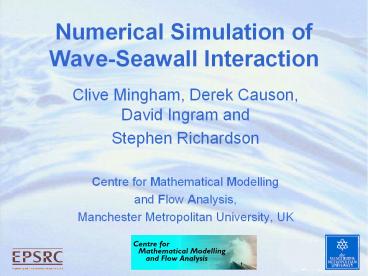Numerical Simulation of Wave-Seawall Interaction PowerPoint PPT Presentation
1 / 29
Title: Numerical Simulation of Wave-Seawall Interaction
1
Numerical Simulation of Wave-Seawall Interaction
- Clive Mingham, Derek Causon, David Ingram and
- Stephen Richardson
- Centre for Mathematical Modelling
- and Flow Analysis,
- Manchester Metropolitan University, UK
2
Outline
- Background
- Experimental set up
- Numerical simulation
- Results
- Conclusions
3
The VOWS Project (Violent Overtopping of Waves
at Seawalls) http//www.vows.ac.uk
- Aim
- To investigate the
- violent overtopping
- of seawalls and help
- engineers design
- better sea defences.
Photo by G. Motyker, HR Wallingford
4
- Experimental
- Edinburgh, and Sheffield
- Universities
- 2D wave flume tests
- In Edinburgh.
- 3D wave basin tests at
- HR Wallingford.
- Numerical
- Manchester Metropolitan
- University
- AMAZON-CC to help
- experimental design
- AMAZON-SC to simulate overtopping
5
- VOWS Experimental Team
- William Allsop (Sheffield).
- Tom Bruce, Jonathan Pearson
- and Nicolas Napp (Edinburgh)
- Funding
- EPSRC - Grant M/42428
6
VOWS Numerical approach
- Use 1-D Shallow Water Equations to simulate
wave flume and compare with experiments - Use 2-D Shallow Water Equations to provide
advice for wave basin experiments - Simulate violent wave overtopping using more
sophisticated numerics (see later)
7
Edinburgh wave flume cross section
Shallow water simulations were reasonable so go
to wave basin
8
Experimental Investigation
19m
Seawall
Water collection system
j
Wave guide
21m
10m
Wave maker
8m
- Schematic of HR Wallingford wave basin
9
Experimental Investigation
- Wave maker 2 blocks, 8, 0.5m units in each
- SWL 0.425 - 0.525m
- Elbow angle j 0, 45, 120o
- Vertical or 110 battered wall
- Wave Climate Regular waves and JONSWAP
- period 1.5s, wave height 0.1m
- Variable wave guide length 5 10m
10
Advice to Experimentalists
- Effect of gap between wave maker and wave guides
- leakage - Wave guide length to balance
- - Diffraction (around corners)
- - Reflection (from wall and sides)
- Wave heights at seawall
- Likely overtopping places
11
Numerical Simulation of Wave Basin AMAZON-CC
- Shallow Water Equations
- provide a cheap 2D (plan) model of the wave
basin which gives qualitative features (but not
correct!) - Cartesian cut cell Method
- Automatic boundary fitting mesh generation
- Moving boundary to simulate wave maker
- Surface Gradient Method (SGM) is used for bed
topography
12
Shallow Water Equations (SWE)
U conserved quantities, H inviscid fluxes, Q
source terms g gravity, h depth, ? g h,
q u i v j velocity, bx, by bed slopes,
13
Semi-discrete approximation
Aij area of cell ij Uij , Qij averages of
U, Q over cell ij defined at cell centre m
number of sides of cell ij nk outward pointing
normal vector to side k whose magnitude is the
length of side k Hk interface fluxes
14
2-step Numerical Scheme
Predictor step
grid cell ij showing interface fluxes and side
vectors
15
Corrector step
solution to Riemann problem at cell interface
H H(U), find U at interface by MUSCL
interpolation
16
MUSCL interpolation
UiR Ui 0.5 ?xi ?Ui UiL Ui - 0.5 ?xi ?Ui
Limited gradient ?Ui
f flux limiter function
17
Approximate Riemann Solver
- HLL
- robust
- efficient
- extends to dry bed - change wave speeds
18
Cartesian Cut Cell Method
- Automatic mesh generation
- Boundary fitted
- Extends to moving boundaries
19
Method
Input vertices of solid boundary (and domain)
solid boundary
20
overlay Cartesian grid
21
Compute solid boundary/cell intersection points
and obtain cut cells
Boundary fitting mesh
22
Classical Cartesian grid gives saw tooth
representation of body
23
Cut cells work for any domain
(adaptive) cut cell grid for a coastline
wave basin
24
Also works for moving bodies e.g. wave maker
25
Cut cell treatment of moving body
- prescribe body (wave maker unit) velocity
- At each time step
- - find the position of the body
- - re-cut the mesh
- - use generalised MUSCL reconstruction
- - use exact Riemann solution at moving
interface
26
AMAZON-CC generation of oblique waves using cut
cells
27
Results
Numerical simulation showing effect of gap
between wave maker and guides
28
Results
- VOWS Numerical simulation of wave
- seawall interaction
29
Conclusions
- The shallow water equations, although technically
incorrect, can provide useful guidance to set up
wave basin experiments - More accurate simulation needs to include
non-shallow water effects like dispersion - AMAZON-CC with its automatic boundary fitted mesh
generation and moving body capability is widely
applicable

